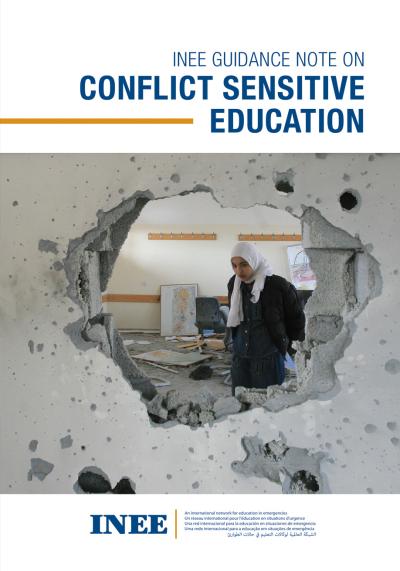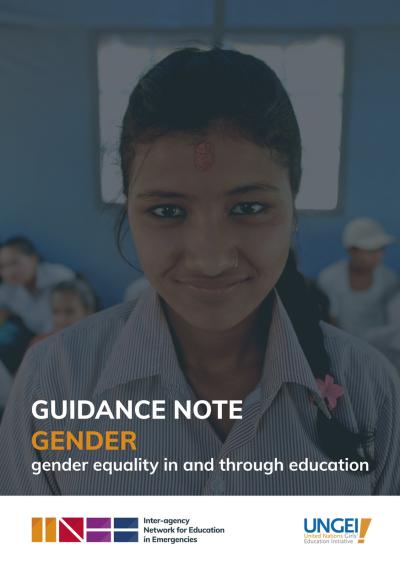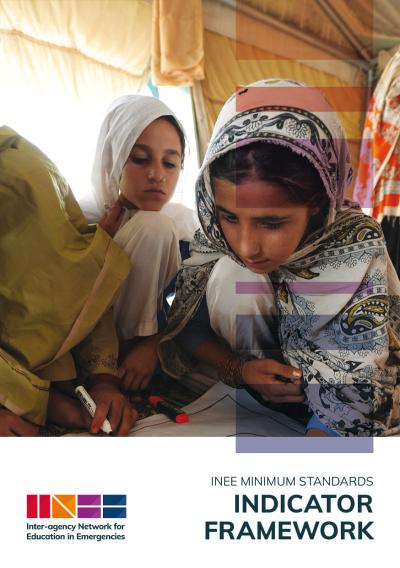Standard 5: Response Strategies
Inclusive education response strategies include a clear description of the context and of the barriers to the right to education, and strategies to overcome those barriers.
On this page
1. Evidence-based response strategies: Reflect the assessment findings accurately in response strategies.
See Guidance Notes:
2. Response planning: Ensure that the education response progressively enables the people affected to access inclusive and equitable quality education.
See Guidance Notes:
3. Do no harm: Design and implement response strategies in ways that do not harm the community or service providers.
See Guidance Notes:
4. Updates to response strategies: Regularly update information collected from the initial assessment and context analysis to guide the education response.
See Guidance Notes:
5. Donor response: Provide enough funds for the response to ensure that the minimum level of education access and quality can be met.
See Guidance Notes:
6. Education system resilience: Include activities in response strategies that support the education authorities, local and national actors, and community members to prepare for, prevent, and respond to future crises.
See Guidance Notes:
7. Harmonization with national programs: Ensure that EiE response strategies complement and align with national education programs.
See Guidance Notes:
8. Baseline data: Collect baseline data systematically at the start of a program.
See Guidance Notes:
Response strategies must be based on evidence and driven by a needs analysis of both the demand side and the supply side. It is important to consider the assistance modality, such as CVA, in-kind, and direct service delivery. Education stakeholders should carefully analyze and interpret the assessment data, and their response strategies should reflect the key findings and major priorities. They should also be aware of biases and assumptions about what people need, and of the most appropriate way to meet those needs. To ensure that the learners’, educators’, and education systems’ specific needs are met, stakeholders may need to adapt and contextualize their response approach to be in line with the information gathered during the assessments.
Education stakeholders should develop a rapid response plan as soon as possible after the onset of a new crisis, or if an existing crisis suddenly worsens. A rapid response plan is typically a condensed version of a broader response strategy. It is implemented during the first phase of a response, usually up to three months. Education should be included in all multi-sectoral rapid response mechanisms. In some situations this may not happen due to contextual constraints, so a separate but complementary education rapid response should be planned, coordinated, and implemented through the education coordination mechanism. Rapid response activities should focus on essential services that address the immediate wellbeing and learning needs of learners and of teachers and other education personnel. These may include providing temporary infrastructure and recreational, creative, and academic materials; conducting initial assessments to determine learning levels to tailor the response; and interventions such as MHPSS, SEL, school meals, and child-friendly spaces. The rapid response services should connect with longer-term programming as soon as possible. It is important to base response strategies on preparedness or contingency plans or, if there are none, to develop these plans with the meaningful and inclusive participation of sub-national or local education authorities and communities (for more guidance, see Strengthening Rapid Education Response Toolkit).
After the first phase of a response, rapid response plans should blend into the broader education response programming. The voices and perspectives of all learners, teachers, and community members should guide the design and implementation of the response strategies. It is also important to acknowledge that programs are implemented within a national policy context which will also influence what response options are available. Increasing learning and protection should be a priority of response strategies. Response strategies can outline the different levels, languages, and types of education, identify the risks and hazards, and indicate whether other agencies or sectors are supporting education activities. The budget for implementing a response strategy should include essential education activities, including baseline data collection, monitoring, and evaluation.
Response strategies should be as flexible as possible to allow education stakeholders to carry out key activities, including the following:
- Analyzing and working to remove barriers to access for all levels and types of education
- Assessing learning levels
- Adapting learning opportunities to meet the needs of all learners
- Providing multiple learning pathways
- Connecting to essential services beyond the education sector, such as protection, MHPSS, nutrition, WASH, health, and food security
During an EiE response, resources like training, jobs, supplies, and food are introduced or distributed in what are often resource-scarce environments. To some, these resources can represent power and wealth. They can become a part of the conflict, worsen the effects of the emergency, or contribute to existing inequalities within the community, such as marginalization or discrimination. In a conflict situation, some people may try to control and use these resources to support their side and weaken the other side, or to gain personally. Stakeholders can use risk and conflict analysis to help ensure that resources are distributed equitably and that the EiE response maximizes positive impact and minimizes negative impact (for more guidance, see INEE Guidance Note on Conflict Sensitive Education).
Transferring resources and conducting an EiE response can also strengthen local actors’ capacity to build peace or promote social cohesion. Awareness raising activities can lessen division and tension by building on or creating ties that bring a community together. For example, teacher professional development programs can unite teachers in their professional identities as educators that bridge ethnic divides. Ensuring the inclusion of marginalized groups in community activities can promote more equitable community relations. Awareness raising efforts also can improve attitudes about the education of persons with disabilities and the contributions they make to the community.
Education stakeholders should regularly review and update their response strategies during emergencies, and through to recovery. Updates should reflect the state of learner’s learning and protection, changes in strategy and what has been achieved, as well as changes in the emergency and security situation. Feedback from learners and teachers on how the response has or has not met their needs and rights should guide the strategy updates. Changing needs should also be reflected in the updated strategy. Education programming should promote progressive improvements in learning, inclusion, equity, coverage, sustainability, and shared ownership. To ensure that education activities are gradually handed over to the relevant parties, updated response strategies should have transition plans and exit strategies in place at levels of education.
Reviewing and updating response strategies can provide opportunities for cross-sectoral collaboration. This may include coordinating and identifying common activities between child protection and the education response, between the ECD response and nutrition programming, or between TVET programs and economic recovery activities.
Humanitarian partners and donors need to regularly review the quality and coverage of the EiE response to ensure that it meets the minimum levels of access and quality. They should pay particular attention to how many learners from vulnerable groups enroll and continue to go to school to ensure that they have equal access to education. “Equal access” means that all children, young people, and adult learners have equal education opportunities, particularly those marginalized because of ethnicity, language, gender, disability, race, or class. Funding for the education response should be available as early as possible when a crisis occurs and should be given the same priority as the water, food, shelter, and health responses. Donors and humanitarian partners must adhere to do no harm principles to ensure that their assistance does not negatively impact communities hosting refugees and/or IDPs, for example by contributing to social tension through unequal support. Adequate funding is critical to fulfilling the right to education for all. Short-term funding cycles should not limit the run of EiE programs, which should continue well into the recovery period.
The EiE response should include activities led by education authorities to build a more resilient system for the future. They should strive to create an inclusive education system for all learners, including those from marginalized groups.
Education authorities, local and national actors, humanitarian and development partners, and donors should work together through coordination mechanisms to promote and support activities for disaster risk management and emergency preparedness. Local and national actors are in the best position to lead an emergency response from preparedness through to recovery, and to guide the transition from a rapid response to a longer-term response. Investment in disaster risk management and preparedness will enable education authorities and their partners to plan, coordinate, and respond more effectively. Measures taken before a crisis and during recovery can include:
- Providing support for education authorities to update or create emergency preparedness plans and contingency plans
- Working with school communities to choose safe sites and buildings, or to repair, rebuild, and retrofit schools, early childhood centers, and other learning environments
- Helping set up early warning systems at the community level
Response strategies should include capacity sharing between education authorities, local and national actors, communities, and external stakeholders. In order to prepare for, prevent, and respond to future crises, capacity sharing should build on challenges and goals identified by communities. This can include:
- Supporting local stakeholders, community members, and young people to implement response activities, such as assessments of the education sector that include data collection and analysis
- Creating professional development opportunities with teachers and other education personnel that focus on comprehensive school safety, teaching social and emotional skills, training learners in DRR, and educating them on climate change at every level of education
- Capacity sharing between local and national actors and international actors and donors to adapt funding policies and procedures to increase partners’ access to direct funding and support continuity and sustainability between crises or programs
It is important to harmonize the EiE response with the national education policies, strategies, and programs reflected in the existing ESP, transitional education plan (TEP), or other national education plans. This is key to ensuring the continuity of learning processes and practices, to creating sustainable exit strategies and/or transition plans, and to supporting the leading role of education authorities. Harmonization can involve national and local education planning, analysis, assessment, coordination, administration and management, and physical infrastructure. For example, the amount spent to compensate teachers and buy equipment should be harmonized across organizations so that spending levels are sustainable over the long term.
Humanitarian organizations with specific mandates and missions, such as supporting children, primary education, or refugees, should make sure that their education response complements those of the education authorities and other education stakeholders. The overall education response strategy should be equitable and inclusive and cover the following:
- ECD and caregiver support
- Primary education
- Education opportunities for young people, including skills building, secondary, higher, technical and vocational, and livelihood education
- Accelerated education and non-formal programs
- Adult education
- Disability-inclusive and gender-responsive education
- Pre-service and in-service teacher training
Response strategies for adult learners should include education literacy and numeracy programs. Survival skills and awareness training are also important in terms of safety and security, such as landmine awareness. Response strategies in situations of displacement or areas with returnee refugees should include longer-term support, such as accelerated education, catch-up classes, bridging programs, vocational training, and higher education opportunities.
Baseline data offers evidence-based insight into the education situation before EiE programs and activities began. The baseline data makes it possible to monitor and evaluate the effects of programs and should be collected systematically. The key data for a strong baseline includes disaggregated population data, school attendance rates, and teacher-student ratios. Data specific to an intervention can also be helpful. For example, if the aim of a program is to improve girls’ school attendance, the baseline is their attendance rates before the program began.
Indicators
| INEE Domain | INEE Standard | Indicator/Program Requirements | Clarification | Numerator | Denominator | Target | Disaggregation | Source of Indicator | Source of Data | Available Tool | Crisis Phase | |
| Foundational Standards | Community Participation | Participation (FDN/Community Participation Std 1) Community members participate actively, transparently, and without discrimination in analysis, planning, design, implementation, monitoring, and evaluation of education responses. |
1.1 Percentage of parents actively participating in the conception and implementation of education in emergencies services | Number of parents consulted | Number of parents | To be defined by program | Gender | Based on OCHA Indicator Registry | Program documentation | No tool required; INEE MS and indicator definitions sufficient | All stages | |
| 1.2 Percentage of parents satisfied with the quality and appropriateness of response at the end of the project | Number of parents satisfied with the quality and appropriateness of response at the end of the project | Number of parents | 100% | NA | Based on OCHA Indicator Registry | Program documentation | Tool required | All stages | ||||
| Resources (FDN/Community Participation Std 2) Community resources are identified, mobilized and used to implement age-appropriate learning opportunities. |
1.3 Analysis of opportunity to use local resources is carried out and acted on | Scale 1-5 (1 = low, 5 = high) | 5 | NA | New | Program/procurement documentation | Tool required | All stages | ||||
| Coordination | Coordination (FDN/Coordination Std 1) Coordination mechanisms for education are in place to support stakeholders working to ensure access to and continuity of quality education. |
1.4 Percentage of regular relevant coordination mechanism (i.e., Education Cluster, EiEWG, LEGs) meetings attended by program team | Number of regular relevant coordination mechanism (i.e.; Education Cluster, EiE Working Group (WG), Local Education Group (LEG) meetings attended by program team | Number of regular relevant coordination mechanism (i.e. Education Cluster, EiEWG, LEGs) meetings held during organizational presence | 100% | NA | New | Meeting records | No tool required; INEE MS and indicator definitions sufficient | All stages | ||
| Analysis | Assessment (FDN/Analysis Std 1) Timely education assessments of the emergency situation are conducted in a holistic, transparent, and participatory manner. |
1.5 Percentage of education needs assessments, carried out by the relevant coordinating body the program has participated in | These include initial rapid and ongoing/rolling assessments | Number of assessments organization contributed to | Number of possible assessments organization could have contributed to | 100% | NA | New | Assessment records | No tool required; INEE MS and indicator definitions sufficient | All stages | |
| Response Strategies (FDN/Analysis Std 2) Inclusive education response strategies include a clear description of the context, barriers to the right to education, and strategies to overcome those barriers. |
1.6 Strength of analysis of context, of barriers to the right to education, and of strategies to overcome those barriers | Scale 1-5 (1 = low, 5 = high) | 5 | NA | New | Program documentation | Tool required | All stages | ||||
| Monitoring (FDN/Analysis Std 3) Regular monitoring of education response activities and the evolving learning needs of the affected population is carried out. |
1.7 Percentage of education needs assessments carried out in defined time period | Frequency to be defined by organization. Monitoring measures should be relevant to the desired program outcomes | Number of education needs assessments carried out per year | Number of education needs assessments required per year | 100% | NA | New | M&E plans and results | No tool required; INEE MS and indicator definitions sufficient | During program implementation | ||
| Evaluation (FDN/Analysis Std 4) Systematic and impartial evaluations improve education response activities and enhance accountability. |
1.8 Number of evaluations carried out | Number of evaluations carried out | NA | NA | New | M&E plans and results | No tool required; INEE MS and indicator definitions sufficient | Program completion | ||||
| 1.9 Percentage of evaluations shared with parents | Number of evaluations shared with parents | Number of evaluations | 100% | NA | New | M&E plans and results | No tool required; INEE MS and indicator definitions sufficient | Program completion | ||||








